Halifax Stanfield International Airport
| Halifax Stanfield International Airport Aéroport international Stanfield d'Halifax | |||||||||||||||
|---|---|---|---|---|---|---|---|---|---|---|---|---|---|---|---|
 | |||||||||||||||
|
| |||||||||||||||
| Summary | |||||||||||||||
| Airport type | Public | ||||||||||||||
| Owner | Transport Canada | ||||||||||||||
| Operator | Halifax International Airport Authority | ||||||||||||||
| Serves | Halifax, Nova Scotia | ||||||||||||||
| Location | Enfield, Nova Scotia | ||||||||||||||
| Opened | June 1960 | ||||||||||||||
| Hub for | Air Canada, Air Canada Express | ||||||||||||||
| Time zone | AST (UTC−04:00) | ||||||||||||||
| • Summer (DST) | ADT (UTC−03:00) | ||||||||||||||
| Elevation AMSL | 477 ft / 145 m | ||||||||||||||
| Coordinates | 44°52′47″N 063°30′37″W / 44.87972°N 63.51028°WCoordinates: 44°52′47″N 063°30′37″W / 44.87972°N 63.51028°W | ||||||||||||||
| Website |
halifaxstanfield | ||||||||||||||
| Map | |||||||||||||||
 CYHZ Location within Nova Scotia | |||||||||||||||
| Runways | |||||||||||||||
| |||||||||||||||
| Statistics (2016) | |||||||||||||||
| |||||||||||||||
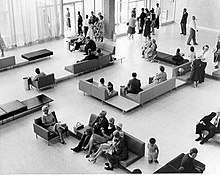
Halifax Stanfield International Airport (IATA: YHZ, ICAO: CYHZ) is a Canadian airport located in Enfield, Nova Scotia, an area of Halifax, Nova Scotia. It serves Halifax, mainland Nova Scotia and adjacent areas in the neighbouring Maritime provinces. The airport is named in honour of Robert Stanfield, the 17th Premier of Nova Scotia and leader of the federal Progressive Conservative Party of Canada.
The airport, owned by Transport Canada since it was constructed, has been operated since 2000 by the Halifax International Airport Authority (HIAA). It forms part of the National Airports System.
The airport is the 8th busiest airport in Canada by passenger traffic. It handled a total of 3,908,799 passengers and 80,278 aircraft movements in 2016. It is a hub for Air Canada Express, Cougar Helicopters, Maritime Air Charter, Provincial Airlines, and SkyLink Express.
History
Establishment and growth
An airfield in the West End, known as Chebucto Field, was built as the Halifax Civic Airport by the City of Halifax in 1931. It served as the city's main airport until 1942, when it was closed and converted to an army base. Today Saunders Park, named after the first Halifax airport manager, marks the site. RCAF Station Shearwater subsequently functioned as Halifax's primary airport until the current airport was opened. In October 1945, the City of Halifax asked the federal Department of Transport for help choosing a site for a new civil airport.[3]
The Kelly Lake site was chosen in 1954 based on a recommendation by Trans-Canada Air Lines. The land was purchased by the City of Halifax while the federal Department of Transport constructed the airport.[3] A key factor was to find a site near Halifax with a minimal number of days per year when fog would affect airport operation. There is a continuing myth that the tree cutting that was required to construct the airport altered the fog patterns, however a weather analysis of the 1960–2008 period would show that this is, indeed, an "urban" myth. The origin of the myth may come from commuters, who may experience very localized fog near the airport during their morning drive along Highway 102.
Construction of the new airport began in November 1955.[4] The runways were built by Diamond Construction of Halifax. The modernist terminal building was designed by Gilleland and Strutt, an architecture firm which previously designed a similar-looking terminal at Ottawa, and built by C.D. Davison and Company of Halifax.[4][5] The new airport was substantially completed in June 1960. At 4:50 am on 1 August 1960 the first airplane landed there, a Vickers Viscount running the Trans-Canada Airlines Flight 400 between Montreal and Newfoundland. It was piloted by Halifax native W.E. Barnes. The first overseas flight arrived an hour later, travelling from London en route to Montreal.[6] The airport was formally inaugurated on 10 September 1960 by the Minister of Transport, George Hees.[7]
Passenger numbers grew steadily during the first few decades of operation. A 5,000-square-metre (54,000 sq ft) passenger terminal extension opened in July 1976. By 1990, approximately 2,500,000 passengers passed through the airport annually, up from about 180,000 when it first opened. A 400-square-metre (4,300 sq ft) southern expansion was opened in December 1994 by Minister of Transport Doug Young, while the check-in area was expanded in 1998.[3]
Owing to the National Airports Policy, announced in 1994, the Halifax International Airport Authority (HIAA) was founded in November 1995. Management of the airport was officially passed from Transport Canada to HIAA on February 1, 2000.[3]
Operation Yellow Ribbon
Following the September 11 attacks the airport took part in Operation Yellow Ribbon, commenced to accept United States civilian flights after the Federal Aviation Administration closed down U.S. airspace. Halifax airport took 40 flights—more flights than any other Canadian airport involved in the operation—carrying about 7,300 passengers—more passengers than any other Canadian airport involved in the operation other than Vancouver, which registered 8,500.[8][9] Much of this was because flights that were coming from Europe were told to avoid the major airports in Central Canada, like Toronto Pearson, Montréal-Dorval, and Ottawa Macdonald–Cartier International Airport.[8]
To honour the people of Gander and Halifax for their support during the operation, Lufthansa named a new Airbus A340-300 "Gander-Halifax" on May 16, 2002. That airplane is listed with the registration D-AIFC,[10] and is the first aircraft of the whole fleet with a city name outside of Germany. On September 11, 2006, five years after the attacks, United States Secretary of State Condoleezza Rice visited Halifax airport and delivered a speech of thanks.[11]
Renaming
On September 9, 2005, the main passenger terminal was renamed in honour of Robert Stanfield, the former Premier of Nova Scotia and federal Leader of the Official Opposition, with a plaque placed on the public observation floor. On Friday February 9, 2007 Prime Minister Stephen Harper arrived at the airport and announced the renaming of the entire facility from "Halifax International Airport" to "Halifax Robert L. Stanfield International Airport" in a further honour to Stanfield; at that time the terminal name was dropped and reverted to its original status.[12]
Awards
Halifax International Airport fared well in the 2005 AETRA survey for passenger satisfaction, produced by the International Air Transport Association (IATA) and Airports Council International. The airport was ranked the best airport in the Americas for the second year in a row, as well as the best airport in the less than 5 million passengers a year category for the third year in a row (worldwide), and best domestic airport for the second year in a row.[13]
In March 2007, the airport earned two first-place finishes in the 2006 Airports Council International (ACI) Service Quality Awards held in Dubai, United Arab Emirates. For the fourth consecutive year, it ranked first in overall passenger satisfaction for airports worldwide with under five million passengers. In addition, the airport ranked first in the Americas in the new category of Airport People Awards, and second in the best domestic airport worldwide category.[14]
In early 2010, Halifax Stanfield was rated by passengers as the Best Airport in the World in its class (under 5 million) for the seventh year in a row.
In 2011 it won third Best Airport in North America of the Airport Service Quality Awards by Airports Council International,[15] as well as 3rd Best Airport by Size in the 2 to 5 million passenger category.[16]
Facilities
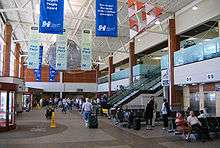

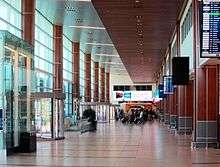
Terminal
The passenger terminal building was opened in September 1960. It serves over 3.5 million passengers per year. The growth experienced in the decades since the airport's construction has necessitated constant renovations, and there is often construction occurring there.
Since 1998, the airport has been undergoing an extensive renovation program. The latest phase was announced in September 2004. The major multi-year expansion project includes a rehabilitation of the runways and taxiways, new terminal expansions, new parking lots (including an enclosed garage), a new hotel, and internal beautifications including an observation tower. The project was expected to cost over $250 million.
In December 2004, U.S. Customs and Border Protection approved Halifax Airport for United States border preclearance. It took effect in late 2006. HIAA used to be the busiest airport in Canada without U.S. Customs preclearance.
On September 12, 2007 the airport authority announced the construction of a 2,300 space, five-storey parking garage, which was completed on March 12, 2009. The airport authority also announced an on-site 175-room Sheraton hotel, which was postponed due to financial considerations. On October 26, 2011 the airport authority announced the construction of an on-site 14-storey, 169-room, ALT Hotel connected to the terminal building. Built by Groupe Germain Hospitality, it opened in spring 2013.
The current terminal contains a total of 31 gate positions, with 12 using airbridges (gates 12, 14–16, 18, 20, 22–24, and 26–28). The remaining gates are ground-loading positions. Gates 22–24 and 26–28 are swing gates: a glassed-in secure corridor allows incoming international passengers and pre-cleared departing US passengers to be segregated from those in the domestic/international departure lounge; when used for US departures, these gates are numbered 52–54 and 56–58, respectively. Gates 2 (a-e) to 9 are ground loading positions dedicated to domestic regional operations. Gates 34 to 46 are ground-loading gate positions for US flights.
Runways and taxiways
In 2010, extension of the taxiway system resulted in an increased airside area, creating space for several newly constructed large hangars. Canadian Helicopters, Cougar Helicopters, Gateway Facilities, and IMP Group operate these new hangars along taxiways J and K.
In November 2012, an extension of both ends of runway 05/23 was completed, for an overall increase in length from 8,800 ft (2,682 m) to 10,500 ft (3,200 m). This increase resulted in the renaming of several associated taxiways.
Hotels
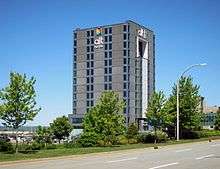
The airport hotel, the 169-room Alt Hotel, is connected to the passenger terminal and the parking garage by a footbridge. The 24-storey, $27 million building was built by Marco Construction of Halifax and opened in 2013. Operated by Groupe Germain Hospitalité, the hotel includes conference and banquet facilities, a fitness centre, a pool, and a 24-hour cafe.[17]
There are three other hotels in the immediate vicinity of the airport. The 156-room Quality Inn is located on the opposite side of Highway 102. The Holiday Inn Express (119 rooms) and the Hilton Garden Inn (145 rooms) are both located in nearby Aerotech Business Park.
Operations
The airport is served by several fixed-base operators (FBOs), which handle fueling, ground handling, hangarage, catering, etc. They include Atlantic Sky Service/Esso Avitat, Shell AeroCentre, and Gateway Facilities.
Halifax Regional Police provides policing at the airport.[18][19] An onsite fire station provides airport fire services with six airport tenders/pumpers.
Halifax International Airport was one of a handful of sites in eastern North America designated an emergency landing site for the Space Shuttle if a launch was aborted following liftoff. The airport kept in contact with Transport Canada and the National Aeronautics and Space Administration during each shuttle launch.[20]
Business park
The airport is located adjacent to the Aerotech Business Park, a municipally-run business park originally catering towards aviation companies. The zoning has since been changed to allow for other types of companies to locate there. The largest tenants are Pratt & Whitney Canada and Northrop Grumman Canada Corporation.[3]
Airlines and destinations

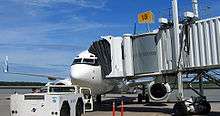
Passenger
Cargo
| Airlines | Destinations |
|---|---|
| FedEx Express operated by Morningstar Air Express | Moncton |
| Korean Air Cargo | Anchorage, Seoul–Incheon |
| Purolator Courier operated by Cargojet Airways | Hamilton, Moncton, Cologne |
| Qatar Airways Cargo | Doha, Zaragoza |
Charter
The following companies operate from private hangars or FBOs at the airport:
- Cougar Helicopters
- Maritime Air Charter
- Provincial Airlines (also leases a Beech Super King Air 200 to Emergency Health Services for use as air ambulance when the EHS helicopter is unavailable)
- Sable Aviation
Statistics
| Year | Passengers | Year | Passengers | Year | Passengers |
|---|---|---|---|---|---|
| 2020 | 2010 | 3,508,153 | 2000 | 2,980,970 | |
| 2019 | 2009 | 3,417,164 | 1999 | 3,089,552 | |
| 2018 | 2008 | 3,578,931 | 1998 | 3,006,572 | |
| 2017 | 2007 | 3,469,062 | 1997 | 2,933,630 | |
| 2016 | 3,908,799 | 2006 | 3,378,601 | 1996 | 2,744,720 |
| 2015 | 3,702,705 | 2005 | 3,229,111 | 1995 | |
| 2014 | 3,663,039 | 2004 | 3,242,389 | 1994 | |
| 2013 | 3,585,864 | 2003 | 2,973,187 | 1993 | |
| 2012 | 3,605,701 | 2002 | 2,853,778 | 1992 | |
| 2011 | 3,594,164 | 2001 | 2,852,061 | 1991 |
Incidents and accidents
- On the night of September 2, 1998, Swissair Flight 111, a scheduled flight from New York City to Geneva, declared a pan-pan after the crew noticed smoke in the cockpit. The flight crew attempted to divert to Halifax after dumping fuel, but crashed into the sea at the entrance of St. Margarets Bay, Nova Scotia, about 60 km from the airport. All 229 passengers and crew perished.[23]
- On February 19, 2003, Air France Concorde flight 002 made an emergency landing after a mechanical failure in engine number 3, causing a massive fuel leak. No injuries were reported and the engine was repaired.
- On October 14, 2004, MK Airlines Flight 1602, a Boeing 747-200F, crashed during takeoff from runway 23. All seven crew members died.[24]
- On the morning of June 14, 2013 a Cargojet Airways Boeing 757 was being unloaded by a 58-year-old male baggage handler, who became trapped by the hydraulic loader and died on scene.[25]
- On March 29, 2015, Air Canada Flight 624 crashed while attempting to land at the airport, shortly after midnight in stormy weather. All 137 passengers and crew survived. The crash cut power to the airport and damaged runway 05's antenna array.[26][27]
Ground transport
Bus
Metro Express route 320 is an express bus service that travels between the city centre and the airport, with two intermediate stops at the Dartmouth Bridge Terminal and the suburb of Fall River. The route is run by Halifax Transit (formerly Metro Transit).[28]
Car
The airport is located at Exit 6 of Highway 102, which connects Halifax to the Trans-Canada Highway. It is a 28-minute drive from Halifax City Hall, the centre of Downtown Halifax. There are numerous car rental agencies located in the lower level of the airport car park.[29]
See also
- Atlantic Canada Aviation Museum – located nearby, offering both military and civil aviation exhibits
References
- ↑ Canada Flight Supplement. Effective 0901Z 27 April 2017 to 0901Z 22 June 2017
- ↑ "Airport Statistics". Halifax Stanfield International Airport. Halifax International Airport Authority. Retrieved 26 April 2017.
- 1 2 3 4 5 "History of Halifax (Stanfield) International Airport" (PDF). Halifax International Airports Authority. December 2015.
- 1 2 "$18,000,000 Airport at Halifax To Be Formally Opened Today". The New York Times. 10 September 1960. p. 42.
- ↑ Ziobrowski, Peter (3 September 2013). "Modernity and Air Travel – Halifax International Air Terminal Building". BuiltHalifax.
- ↑ "New Canadian Airport". The New York Times. 2 August 1960. p. 59.
- ↑ "Halifax Opens New Airport". The New York Times. 11 September 1960. p. 42.
- ↑ "Airport Acknowledges Tenth Anniversary of September 11th". Halifax/Stanfield International Airport Newsroom. September 9, 2011. Retrieved September 10, 2011.
- ↑ D-AIFC at airliners.net
- ↑ Rice, Condoleezza (11 September 2006). "Remarks to Halifax International Airport Officials and Staff". United States Department of State.
- ↑ Canada's New Government Renames Halifax International Airport in Honour of Robert L. Stanfield
- ↑ Phillips, Don (8 March 2006). "Travelers call Incheon best airport". International Herald Tribune. p. 15.
- ↑ World's top customer service airports for 2006
- ↑ "ASQ Award for Best Airport in North America" Airports Council International. 14 February 2012. Retrieved 2012-04-13
- ↑ "ASQ Award for Best Airport by Size (2-5m)" Airports Council International. 14 February 2012. Retrieved 2012-04-13
- ↑ "Alt Hotel Halifax Airport". Le Germain Hotels. Retrieved 19 May 2017.
- ↑ Willick, Frances (4 December 2015). "Halifax police win airport contract, to take over security from RCMP". Halifax Chronicle-Herald.
- ↑ Woodford, Zane (19 January 2016). "Details emerge about Halifax Regional Police contract for airport security". Metro Halifax.
- ↑ Lambie, Chris (5 July 2006). "Halifax possible shuttle pit stop". Halifax Chronicle-Herald.
- ↑ Taking Flight: 2000 Annual Report (pg 11). Retrieved on Apr 3, 2015.
- ↑ Airport Statistics. Retrieved on Feb 28, 2016.
- ↑ Aviation Investigation Report A98H0003: In-Flight Fire Leading to Collision with Water. Transportation Safety Board of Canada. 27 March 2003.
- ↑ Aviation Investigation Report A04H0004: Reduced Power at Take-off and Collision with Terrain. Transportation Safety Board of Canada. 6 April 2006. ISBN 0-662-43546-X.
- ↑ Hradecky, Simon (19 June 2013). "Accident: Cargojet B752 at Halifax on Jun 14th 2013, ground worker trapped under hydraulic loader". The Aviation Herald.
- ↑ "Air Canada AC624 touched down 335 metres short of runway, TSB says". CBC News. 29 March 2015.
- ↑ Aviation Investigation Report A15H0002: Collision with terrain. Transportation Safety Board of Canada. 18 May 2017. ISBN 978-0-660-08379-7.
- ↑ "MetroX Service". Halifax Transit. Retrieved 4 May 2017.
- ↑ "Car rentals". Halifax Stanfield International Airport. Retrieved 4 May 2017.
External links
-
 Media related to Halifax International Airport at Wikimedia Commons
Media related to Halifax International Airport at Wikimedia Commons - Official website
- Past three hours METARs, SPECI and current TAFs for Halifax International Airport from Nav Canada as available.